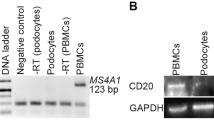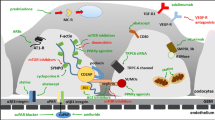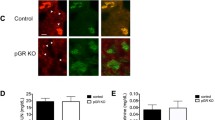Abstract
Background
In the absence of mutant genes encoding components of the podocyte slit diaphragm, about 30–50 % of children with primary glucocorticoid-resistant focal segmental glomerulosclerosis (FSGS) develop recurrent proteinuria and slowly progressive FSGS lesions following renal transplantation. Recurrence of FSGS in the allograft strongly suggests a circulating factor that disturbs normal podocyte biology. To date, the nature of the circulating factor is unclear, and there is no cure for the recurrent form of FSGS (R-FSGS).
Methods
Cultured differentiated human podocytes were exposed to the plasmapheresis effluent or blood plasma samples from pediatric patients with recurrent or primary FSGS; in some cases, podocytes were pre-incubated with specific antibodies to block the tumor necrosis factor-alpha (TNFα) signaling pathway. Integrity of focal adhesion complexes and actin cytoskeleton were investigated by immunofluorescent microscopy.
Results
Plasmapheresis effluent from an R-FSGS child or fresh plasma from two children with primary FSGS rapidly disturbed the cytoskeleton of normal human podocytes in vitro. Plasma from a child with R-FSGS also activated β3 integrin and dispersed focal adhesion complexes. The effects were reversed by pre-incubation with antibodies against TNFα or either of the two TNFα receptors. When our patient with R-FSGS became resistant to plasmapheresis, we initiated treatment with twice weekly etanercept injections and then infliximab. Within 3 weeks of regular anti-TNFα therapy, the patient achieved sustained partial remission of proteinuria, allowing us to wean her off plasmapheresis completely.
Conclusions
We suggest that in some FSGS patients, disruption of the podocyte cytoskeleton and β3 integrin-mediated podocyte attachment are driven by the TNFα pathway.





Similar content being viewed by others
References
Ernould S, Godron A, Nelson JR, Rigothier C, Llanas B, Harambat J (2011) Idiopathic nephrotic syndrome in children: incidence, clinical presentation, and outcome in the county of Gironde, France. Arch Pediatr 18:522–528
Rich AR (1957) A hitherto undescribed vulnerability of the juxtamedullary glomeruli in lipoid nephrosis. Bull Johns Hopkins Hosp 100:173–186
D'Agati VD (2008) The spectrum of focal segmental glomerulosclerosis: new insights. Curr Opin Nephrol Hypertens 17:271–281
Pollak MR (2008) Focal segmental glomerulosclerosis: recent advances. Curr Opin Nephrol Hypertens 17:138–142
Hoyer JR, Vernier RL, Najarian JS, Raij L, Simmons RL, Michael AF (1972) Recurrence of idiopathic nephrotic syndrome after renal transplantation. Lancet 2:343–348
Marszal J, Saleem MA (2006) The bioactivity of plasma factors in focal segmental glomerulosclerosis. Nephron Exp Nephrol 104:e1–5
Canaud G, Dion D, Zuber J, Gubler MC, Sberro R, Thervet E, Snanoudj R, Charbit M, Salomon R, Martinez F, Legendre C, Noel LH, Niaudet P (2010) Recurrence of nephrotic syndrome after transplantation in a mixed population of children and adults: course of glomerular lesions and value of the Columbia classification of histological variants of focal and segmental glomerulosclerosis (FSGS). Nephrol Dial Transplant 25:1321–1328
Lagrue G, Branellec A, Niaudet P, Heslan JM, Guillot F, Lang P (1991) Transmission of nephrotic syndrome to two neonates. spontaneous regression. Presse Med 20:255–257
Suranyi MG, Guasch A, Hall BM, Myers BD (1993) Elevated levels of tumor necrosis factor-alpha in the nephrotic syndrome in humans. Am J Kidney Dis 21:251–259
Bakr A, Shokeir M, El-Chenawi F, El-Husseni F, Abdel-Rahman A, El-Ashry R (2003) Tumor necrosis factor-alpha production from mononuclear cells in nephrotic syndrome. Pediatr Nephrol 18:516–520
Leroy S, Guigonis V, Bruckner D, Emal-Aglae V, Deschenes G, Bensman A, Ulinski T (2009) Successful anti-TNFalpha treatment in a child with posttransplant recurrent focal segmental glomerulosclerosis. Am J Transplant 9:858–861
Joy MS, Gipson DS, Powell L, MacHardy J, Jennette JC, Vento S, Pan C, Savin V, Eddy A, Fogo AB, Kopp JB, Cattran D, Trachtman H (2010) Phase 1 trial of adalimumab in Focal Segmental Glomerulosclerosis (FSGS): II. Report of the FONT (Novel Therapies for Resistant FSGS) study group. Am J Kidney Dis 55:50–60
Babayeva S, Miller M, Zilber Y, El Kares R, Bernard C, Bitzan M, Goodyer P, Torban E (2011) Plasma from a case of recurrent idiopathic FSGS perturbs non-muscle myosin IIA (MYH9 protein) in human podocytes. Pediatr Nephrol 26:1071–1081
Saleem MA, O'Hare MJ, Reiser J, Coward RJ, Inward CD, Farren T, Xing CY, Ni L, Mathieson PW, Mundel P (2002) A conditionally immortalized human podocyte cell line demonstrating nephrin and podocin expression. J Am Soc Nephrol 13:630–638
Coward RJ, Foster RR, Patton D, Ni L, Lennon R, Bates DO, Harper SJ, Mathieson PW, Saleem MA (2005) Nephrotic plasma alters slit diaphragm-dependent signaling and translocates nephrin, podocin, and CD2 associated protein in cultured human podocytes. J Am Soc Nephrol 16:629–637
Wei C, El Hindi S, Li J, Fornoni A, Goes N, Sageshima J, Maiguel D, Karumanchi SA, Yap HK, Saleem M, Zhang Q, Nikolic B, Chaudhuri A, Daftarian P, Salido E, Torres A, Salifu M, Sarwal MM, Schaefer F, Morath C, Schwenger V, Zeier M, Gupta V, Roth D, Rastaldi MP, Burke G, Ruiz P, Reiser J (2011) Circulating urokinase receptor as a cause of focal segmental glomerulosclerosis. Nat Med 17:952–960
Honda S, Tomiyama Y, Pelletier AJ, Annis D, Honda Y, Orchekowski R, Ruggeri Z, Kunicki TJ (1995) Topography of ligand-induced binding sites, including a novel cation-sensitive epitope (AP5) at the amino terminus, of the human integrin beta 3 subunit. J Biol Chem 270:11947–11954
Baud V, Karin M (2001) Signal transduction by tumor necrosis factor and its relatives. Trends Cell Biol 11:372–377
Clark IA (2007) How TNF was recognized as a key mechanism of disease. Cytokine Growth Factor Rev 18:335–343
Misseri R, Meldrum DR, Dinarello CA, Dagher P, Hile KL, Rink RC, Meldrum KK (2005) TNF-alpha mediates obstruction-induced renal tubular cell apoptosis and proapoptotic signaling. Am J Physiol Renal Physiol 288:F406–411
Khan SB, Cook HT, Bhangal G, Smith J, Tam FW, Pusey CD (2005) Antibody blockade of TNF-alpha reduces inflammation and scarring in experimental crescentic glomerulonephritis. Kidney Int 67:1812–1820
Sanchez-Nino MD, Benito-Martin A, Goncalves S, Sanz AB, Ucero AC, Izquierdo MC, Ramos AM, Berzal S, Selgas R, Ruiz-Ortega M, Egido J, Ortiz A (2010) TNF superfamily: a growing saga of kidney injury modulators. Mediators Inflamm. doi:10.1155/2010/182958
McCarthy ET, Sharma R, Sharma M, Li JZ, Ge XL, Dileepan KN, Savin VJ (1998) TNF-alpha increases albumin permeability of isolated rat glomeruli through the generation of superoxide. J Am Soc Nephrol 9:433–438
Kolb WP, Granger GA (1968) Lymphocyte in vitro cytotoxicity: characterization of human lymphotoxin. Proc Natl Acad Sci USA 61:1250–1255
Carswell EA, Old LJ, Kassel RL, Green S, Fiore N, Williamson B (1975) An endotoxin-induced serum factor that causes necrosis of tumors. Proc Natl Acad Sci US A72:3666–3670
Wallach D, Varfolomeev EE, Malinin NL, Goltsev YV, Kovalenko AV, Boldin MP (1999) Tumor necrosis factor receptor and Fas signaling mechanisms. Annu Rev Immunol 17:331–367
Faustman D, Davis M (2010) TNF receptor 2 pathway: drug target for autoimmune diseases. Nat Rev Drug Discov 9:482–493
Lai KN, Leung JC, Chan LY, Saleem MA, Mathieson PW, Tam KY, Xiao J, Lai FM, Tang SC (2009) Podocyte injury induced by mesangial-derived cytokines in IgA nephropathy. Nephrol Dial Transplant 24:62–72
Bruggeman LA, Drawz PE, Kahoud N, Lin K, Barisoni L, Nelson PJ (2011) TNFR2 interposes the proliferative and NF-kappaB-mediated inflammatory response by podocytes to TNF-alpha. Lab Invest 91:413–425
Kakiashvili E, Speight P, Waheed F, Seth R, Lodyga M, Tanimura S, Kohno M, Rotstein OD, Kapus A, Szaszi K (2009) GEF-H1 mediates tumor necrosis factor-alpha-induced Rho activation and myosin phosphorylation: role in the regulation of tubular paracellular permeability. J Biol Chem 284:11454–11466
Koukouritaki SB, Vardaki EA, Papakonstanti EA, Lianos E, Stournaras C, Emmanouel DS (1999) TNF-alpha induces actin cytoskeleton reorganization in glomerular epithelial cells involving tyrosine phosphorylation of paxillin and focal adhesion kinase. Mol Med 5:382–392
Doublier S, Ruotsalainen V, Salvidio G, Lupia E, Biancone L, Conaldi PG, Reponen P, Tryggvason K, Camussi G (2001) Nephrin redistribution on podocytes is a potential mechanism for proteinuria in patients with primary acquired nephrotic syndrome. Am J Pathol 158:1723–1731
Ryu M, Mulay SR, Miosge N, Gross O, Anders HJ (2012) Tumour necrosis factor-alpha drives Alport glomerulosclerosis in mice by promoting podocyte apoptosis. J Pathol 226:120–131
Savin VJ, McCarthy ET, Sharma R, Charba D, Sharma M (2008) Galactose binds to focal segmental glomerulosclerosis permeability factor and inhibits its activity. Transl Res 151:288–292
McCarthy ET, Sharma M, Sharma R, Falk RJ, Jennette JC (2004) Sera from patients with collapsing focal segmental glomerulosclerosis increase albumin permeability of isolated glomeruli. J Lab Clin Med 143:225–229
Wei C, Moller CC, Altintas MM, Li J, Schwarz K, Zacchigna S, Xie L, Henger A, Schmid H, Rastaldi MP, Cowan P, Kretzler M, Parrilla R, Bendayan M, Gupta V, Nikolic B, Kalluri R, Carmeliet P, Mundel P, Reiser J (2008) Modification of kidney barrier function by the urokinase receptor. Nat Med 14:55–63
D'Agati VD, Fogo AB, Bruijn JA, Jennette JC (2004) Pathologic classification of focal segmental glomerulosclerosis: a working proposal. Am J Kidney Dis 43:368–382
Acknowledgments
We are indebted to the patients and their families for participating in the study. We thank LeeLee Chu, Annes Siji, and Ashwini Raghavendra for their excellent technical assistance with the Bangalore samples. The study was supported by an infrastructure support grant to the McGill University Health Centre Research Institute from the Fonds de la Recherche du Québec-Santé and by an operating grant to ET from the Canadian Institutes of Health Research. PG is the recipient of a James McGill Research Chair. ET is the recipient of the Fonds de la Recherche du Québec-Santé Chercheur Boursier Junior award. Collaboration between the Montreal Children’s Hospital and St. John’s Medical College Hospital (Bangalore) was supported by an International Society of Nephrology Sister Centre grant.
Author information
Authors and Affiliations
Corresponding author
Electronic supplementary material
Below is the link to the electronic supplementary material.
Supplementary Figure 1
Blockade of the TNFα pathway restores actin arrangement in cultured podocytes. Differentiated podocytes were incubated for 12 h with 5 % plasma from a healthy age-matched child (upper figure) or 5 % plasma from two children with primary glucocorticoid-resistant FSGS. Pre-incubation of podocytes for 1 h with 0.1 μg/mL of anti-TNFα or 0.2 μg/mL of anti-TNFRI antibodies restored filamentous actin (phalloidin, red) and podocyte shape. (JPG 396 kb)
Supplementary Table 1
(DOC 30 kb)
Rights and permissions
About this article
Cite this article
Bitzan, M., Babayeva, S., Vasudevan, A. et al. TNFα pathway blockade ameliorates toxic effects of FSGS plasma on podocyte cytoskeleton and β3 integrin activation. Pediatr Nephrol 27, 2217–2226 (2012). https://doi.org/10.1007/s00467-012-2163-3
Received:
Revised:
Accepted:
Published:
Issue Date:
DOI: https://doi.org/10.1007/s00467-012-2163-3




